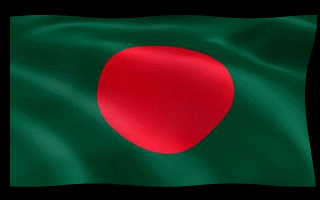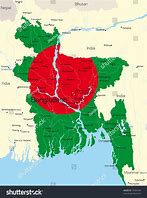History of Bangladesh:
For centuries, the area that is now Bangladesh was part of the Bengal region of India. It was ruled by the same empires that ruled central India, from the Maurya (321–184 BCE) to the Mughal (1526–1858 CE). When the British took control of the region and created their Raj in India (1858–1947), Bangladesh was included. During the negotiations surrounding independence and the partition of British India, predominantly Muslim Bangladesh was separated from majority-Hindu India. In the Muslim League's 1940 Lahore Resolution, one of the demands was that the majority-Muslim sections of the Punjab and Bengal would be included in Muslim states, rather than remaining with India. After communal violence broke out in India, some politicians suggested that a unified Bengali state would be a better solution. This idea was vetoed by the Indian National Congress, led by the Mahatma Gandhi. At the end, when British India gained its independence in August 1947, the Muslim section of Bengal became a non-contiguous part of the new nation of Pakistan. It was called "East Pakistan." East Pakistan was in an odd position, separated from Pakistan proper by a 1,000-mile stretch of India. It was also divided from the main body of Pakistan by ethnicity and language; Pakistanis are primarily Punjabi and Pashtun, as opposed to the Bengali East Pakistanis. For 24 years, East Pakistan struggled under financial and political neglect from West Pakistan. Political unrest was endemic in the region, as military regimes repeatedly overthrew democratically elected governments. Between 1958 and 1962, and from 1969 to 1971, East Pakistan was under martial law. In the parliamentary elections of 1970–71, East Pakistan's separatist Awami League won every single seat allocated to the East. Talks between the two Pakistans failed, and on March 27, 1971, Sheikh Mujibar Rahman declared Bangladeshi independence from Pakistan. The Pakistani Army fought to stop the secession, but India sent troops to support the Bangladeshis. On January 11, 1972, Bangladesh became an independent parliamentary democracy. Sheikh Mujibur Rahman was the first leader of Bangladesh, from 1972 until his assassination in 1975. The current prime minister is Sheikh Hasina Wajed.
Economy:
Bangladesh is a developing country, with per capita GDP of just about $4,200 U.S. per year as of 2017. Nevertheless, the economy is growing rapidly, with a roughly 6% annual growth rate from 2005 to 2017. Although manufacturing and services are increasing in importance, almost half of the Bangladeshi workers are employed in agriculture. Most factories and enterprises are owned by the government and tend to be inefficient. One important source of income for Bangladesh has been workers' remittances from the oil-rich Gulf states such as Saudi Arabia and the UAE. Bangladeshi workers sent $13 billion U.S. home in FISCAL YEAR 2016–2017.


- Flag and Map of Bangladesh
Culture of Bangladesh:
Bangladesh has a rich, diverse culture. Its deeply rooted heritage is thoroughly reflected in its architecture, dance, literature, music, painting and clothing. The three primary religions of Bangladesh (Hinduism, Buddhism and Islam) have had a great influence on its culture and history. The people of Bangladesh have a rich fictional legacy, with the first available form of literature being over a thousand years old. Bengali literature developed considerably during the medieval period with the rise of popular poets such as Chandi Das, Daulat Kazi an Alaol. The traditional music of Bangladesh is very much the same as that of the Indian sub-continent. The music in Bangladesh can be divided into three main categories: classical, modern and folk. Both vocal and instrumental classical music is enjoyed in Bangladesh. Ustad Ayet Ali Khan and Ustad Alauddin are two famous classical instrumental players that are internationally known. Modern music is becoming more popular and is practiced widely. Contemporary, pop songs and bands are also enjoying more widespread fame, but are mainly popular in the regions of Dhaka City. Tribal dances are very popular among the Bangalees. The countryside girls are in the habit of dancing to popular folk music. Their dances require no regulations as such, just a small amount of courage and a big amount of rhythm. Popular songs like Shari and Jari are presented with the accompanying dance of both male and female performers. Drama and theatre is an old tradition that is very popular in Bangladesh. More than a dozen theater groups in Dhaka City have been regularly staging locally written plays for hundreds of years. Many have also started adopted some plays from European writers. Baily Road in Dhaka is known as “Natak Para” and this is one location where drama shows are regularly held. Many shows are also held at the Dhaka University.Another important aspect of the culture of Bangladesh is clothing. Bangladeshi woman usually wear Saris, made of the world famous and expensive, finely embroidered quilted patchwork cloth produced by the village woman. Woman will traditionally wear their hair in a twisted bun, which is called the “Beni style”. Hindus will traditionally wear Dhuty for religious purposes. These days most men of Bangladesh wear shirts and pants.
